Tony Smith's Home Page
At the Millenium,
Experimental Observations tell us
a lot about Cosmology.
The Inflationary Universe begins with an
empty universe and a non-zero cosmological term, which is
mathematically equivalent to a negative pressure, so the origin of
the universe is a lot like the Bhuddist picture of the
void torn apart by the Chinese hermit Ryu playing his iron flute in
the reverse direction. (See "The World is Sound: Nada Brahma" by
Joachim-Ernst Berendt, Destiny (1987, 1991), p. 170)
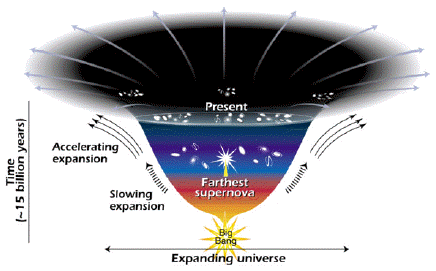
- After about 10^(-34) seconds, Exponentially
Expanding Inflation ends due to Zizzi Self-Decoherence and
SU(5) Unification ends;
- Reheating occurs and raises the
energy/temperature to about Ereh = 10^14 GeV;
- the Universe enters the Radiation-Dominated Era, in which its
scale expands as t ^1/2;
- after about 10^3 years, the Radiation Era ends and the
Universe enters the present Matter-Dominated era, in which its
scale expands as t^2/3.
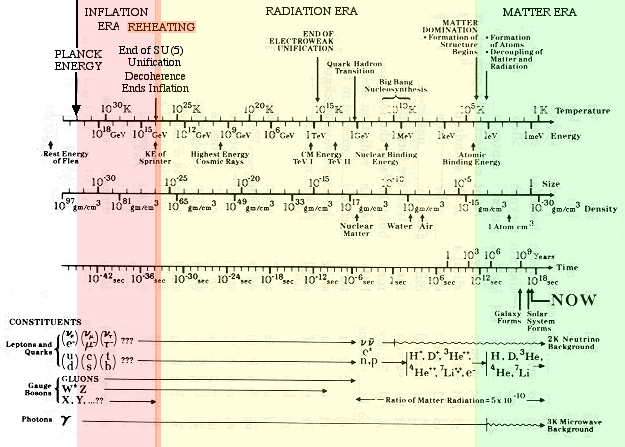
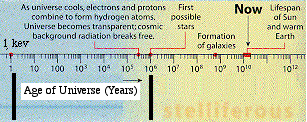
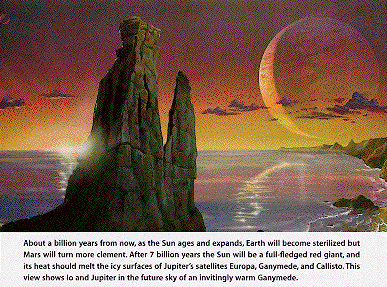
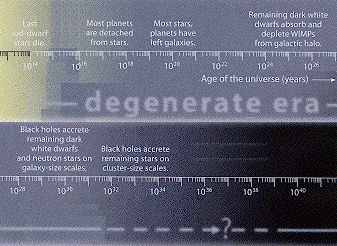
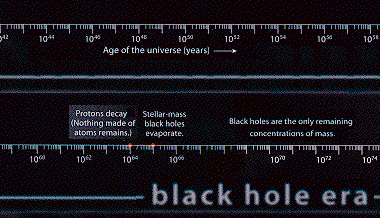
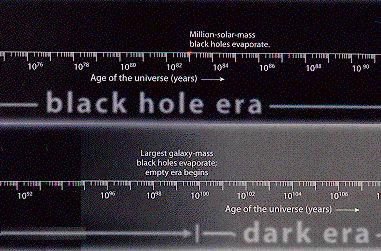
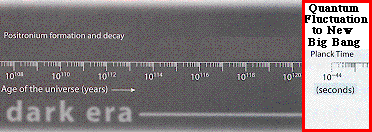
After the Universe has expanded to a very dilute state, a
New Inflationary Universe can form
from a Quantum Fluctuation.
The first of the above 7 images is adapted from Figure 3.7 of The
Early Universe, by Edward W. Kolb and Michael S. Turner (paperback
edition, Addison-Wesley 1994), and the other 6 of the above 7 images
are adapted from the article The Future of the Universe, by Fred C.
Adams and Gregory Laughlin, Sky and Telescope Magazine, August 1998,
pages 32-39.
Some Interesting Times:
Table of Contents:
NOTE: Due to typographical limitations of
HTML, sometimes } denotes greater than, { less than, and k the
Laplacian.
Albert Einstein was almost run down
by several cars when he stopped in his tracks while crossing a street
in Princeton. What caused Einstein to stop in the middle of a street?
It was an IDEA - that matter, stars, or perhaps even all the
Particles in the Universe might be Created From Nothing, because its
negative gravitational energy equals its positive rest mass
energy.
( Note - my comments within quotations are set off by
brackets [ ] . )
The paper
gr-qc/0007006 by Paola Zizzi shows that
"... during inflation, the universe can be described as a
superposed state of quantum
... [ qubits ].
... [ Tdecoh = 10^9 Tplanck = 10(-34) sec ]
...
and
corresponds to a superposed state of ... [ 10^19 =
2^64 qubits ]. ...
... This is also the number of superposed tubulins-qubits
in our brain ... leading to a conscious event. ...".
In a subsequent
paper, gr-qc/0103002, Paola Zizzi says:
"... We consider a quantum gravity register that is a
particular quantum memory register which grows with time, and
whose qubits are pixels of area of quantum de Sitter horizons. At
each time step, the vacuum state of this quantum register grows
because of the uncertainty in quantum information induced by the
vacuum quantum fluctuations. The resulting virtual states,
(responsible for the speed up of growth, i.e., inflation), are
operated on by quantum logic gates and transformed into qubits.
... We also show that the bound on the speed of computation,
the bound on clock precision, and the holographic bound, are
saturated by the QGN. ...
... The model of quantum growing network (QGN) described here
is exactly solvable, and (apart from its cosmological
implications), can be regarded as the first attempt toward a
future model for the quantum World-Wide Web. ... A quantum Web
could even undergo conscious
experiences, if we believe ... that conscious experiences are due
to decoherence of tubulins-qubits ... The idea of a conscious
quantum Web is quite in agreement with the Global Brain idea ... (
the Net becoming the brain of a
superorganism of which humans are just a component ). ...
... One could argue that the QGN discussed in this paper, is
one of the attractors of some
self-organizing system. That self-organizing system might be
some kind of non local and non causal
space-time structure made up of entangled qubits ... Although
that system does not represent any physical space-time, it can be
considered as a proto space-time, which is the seed of physical
quantum space-time. ... we think that ... a random and non-local
structure exists just below the Planck scale. At the Planck scale,
the random network has already self-organized into the QGN.
Indeed, we believe that the quantum beginning of physical
space-time took place at the node 0 (the Hadamard gate) of the
QGN. Quantized time appears as the result of the transformation of
virtual states (vacuum energy) into qubits (quantum information)
at the nodes of a quantum network. ...
... The speed up of the growth of the QGN, is due to virtual
states and it is responsible for quantum inflation. If virtual
states were absent in the quantum network, the growth would be
much slower. In that case, the early universe could be interpreted
as a 2^n lattice (n=0,1,2…), represented by the regular tree
graph ...
... we have three "degrees" (or phases) for the beginning of
the universe:
... The beginning of
existence of the universe (at the end of inflation due to
decoherence) coincided with a cosmic conscious event ... of
which our brain structure is still
reminiscent. ...".
[ My view of what
happens next, after decoherence and the end of inflation, may not
be exactly the same as that of Paola Zizzi, but I think that it is in
the spirit of her work. My view is:
A few months after writing gr-qc/0103002,
Paula Zizzi wrote gr-qc/0110122,
in which she said:
"... In a previous paper (gr-qc/0103002),
the inflationary universe was described as a quantum growing
network (QGN). Here, we propose our view of the QGN as the
"ultimate Internet", as it saturates the quantum limits to
computation. ... The QGN can be ... divided into two
sub-systems:
- ... the connected part, made of connecting links and
nodes, (quantum fluctuations ...) ... the quantum foam
...[which]... can be thought of as the
"environment" ...
- ... the disconnected part ...[which]... can
be thought of as the quantum state ...
... Also, we ...[discuss]... some features of the QGN
which are related to:
- ... the cosmological constant problem ... and ...
the quantum computational aspects of spacetime foam and
decoherence ...
... as the QGN describes the early inflationary universe,
the decohence time corresponds to the end of inflation, and the
decoherence energy corresponds to the reheating energy. ... We
can visualize the QGN after decoherence as a regular lattice,
the connected part of the QGN itself. ...
... inflation ... is due to the presence of virtual
qubits in the vacuum state of the quantum memory register.
Virtual quantum information is created by quantum vacuum
fluctuations, because of the inverse relation [...
gr-qc/0103002
...] between the quantized cosmological constant [...
hep-th/9808180
...] and quantum information I :
...
/\_n = 1 / I (L_planck)^2
where: n = 0,1,2,3... and the quantum information I is
[... gr-qc/9907063
...] : ...
I = N = (n+1)^2
... [leading] to: ...
delta_I = - delta_/\ / ( (L_planck)^2 /\^2 ) = 2n
+3
... That is, at each time step t_n, there are 2n+3 extra
bits (virtual states) in the vacuum state of the quantum memory
register, where: ...
t_n = (n+1) t_planck
is the quantized time, and t_planck = 10^(-43) sec . is the
Planck time. ...
... We calculate the present value of the quantized
cosmological constant ... with n_now = 9 x 10^60, and we get:
...
/\_now = 1.25 x 10^(-52) m^(-2)
Also, we obtain: ...
OMEGA_/\ = /\ c^2 / 3 H_o^2 = (1/3) /\ c^2
(t_now)^2
Where ... t_now = H_o^(-1) = 3 x 10^17 h^(-1) sec
H_o being the Hubble constant and h a dimensionless
parameter in the range: 0.58 < h < 0.72 .
By choosing h = 0.65, we get: ...
OMEGA_./\ = 0.7
... quite in agreement with the
Type Ia SN observation data ...
From this result, the connecting links (virtual states) of
the QGN look like to be still active. But the value of the
total entropy is too big, for n_now = 10^60 : it would be S_now
= 10^120 ln(2) , indeed a huge amount of entropy. We believe
that ... at some earlier time, the QGN decohered
...[and]... the free links were not activated anymore
by the nodes, since the decoherence time. We can visualize
the QGN after decoherence as a
regular lattice, the connected part of the QGN
itself. ...
... The speed of computation v of a system of average energy
E , is bounded as ... : ...
v < 2 E / pi hbar
... The energy of node "n" is ... the energy ... of the nth
quantum fluctuation of the ... connected ... nodes ... : ..
E = E_planck / (n+1)
... E_planck = 10^19 GeV is the Planck energy ... we have :
...
E_now(nodes) = E_planck / n_now = 10^(-41) GeV =
10^(-51) J
for n -> infinity, quantum information I will grow to
infinity as n^2, while the energy of the nodes will decrease to
zero as 1 / n . ... a low energy just reflects ... a low speed
of computation v but not ... a low amount of information. ...
it follows : ...
v_now = 10^(-17) sec^(-1)
... in our case, v_now^(-1) is the age of the universe:
v_now^(-1) = 10^17 sec
... Ng showed [... hep-th/0010234
... gr-qc/0006105
...] ... the bounds on speed of computation v and
information I can be reformulated respectively as : ...
v^2 < P / hbar
I < hbar / P t_planck^2
where P is the mean input power ...[leading]... to a
simultaneous ... bound on the information I and the speed of
computation v : ...
I v^2 < 1 / t_planck^2
... from the simultaneous bound ... we get : I_now
< 10^120 ...
... The quantum entropy of N = I qubits is: S = I ln(2).
...[if the bound were saturated]... We would get .. a
huge total entropy S_now = 10^120 ln(2) ...
... to get the actual entropy [now], one should
compute it as: ...
S_now = 10^120 ln(2) / S_decoherence = 10^120 /
I_max
If one agrees with Penrose [... The Emperor's New Mind,
Oxford University Press (1989). in which Penrose says:
- "... let us consider what was previously thought to
supply the largest contribution to the entropy of the
universe, namely the 2.7 K black-body background radiation.
... The background radiation entropy is something like 10^8
for every baryon (where I am now choosing 'natural units',
so that Boltzmann's constant, is unity). (In effect, this
means that there are 10^8 photons in the background
radiation for every baryon.) Thus, with 10^80 baryons in
all, we should have a total entropy of 10^88 for the entropy
in the background radiation in the universe. Indeed, were it
not for the black holes, this
figure would represent the total entropy of the universe,
since the entropy in the background radiation swamps that in
all other ordinary processes. The entropy per baryon in the
sun, for example, is of order unity. On the other hand, by
black-hole standards, the background radiation entropy is
utter 'chicken feed'. For the Bekenstein-Hawking formula
tells us that the entropy per baryon in a solar mass black
hole is about 10^20, in natural units, so had the universe
consisted ... of ... galaxies ...[consisting]...
mainly of ordinary stars - some 10^11 of them - and each to
have a million (i.e. 10^6) solar-mass black hole at its core
... Calculation shows that the entropy per baryon would now
be actually ... 10^21, giving a total entropy, in natural
units, of 10^101 ...]
... that the entropy now should be of order 10^101, this
corresponds to the maximum amount of quantum information at the
moment of decoherence: ...
I_max = 10^19 (n_cr = 10^9)
where n_cr stands for the critical number of nodes which are
needed to process the maximum quantum information, I_max ... it
follows that the early quantum computational universe decohered
at ...
t_decoherence = 10^(-34) sec.
Moreover ... we find that the mean energy at the moment of
decoherence ( n = 10^9) is: ...
E_decoherence = 10^10 GeV = 1 J
corresponding to a rest mass m_decoherence = 10^(-13) g
... we get, for n = 10^9 : ...[the average speed of
computation up to decoherence (i.e., during inflation)
vbar_decoherence is given by]...
vbar_decoherence = I_ max / t_decoherence = 10^53
sec^(-1)
...
- ... the "information
loss" puzzle ...[and]... the problem of
causality at the Planck scale ...
... the semiclassical arguments of black
holes evaporation might fail at the Planck scale. When the
black hole reaches the Planck mass
[about 10^19 proton masses], strong quantum gravity
effects might stop the evaporation process ...[and]...
there would be a remnant, which should store all the
information collapsed in the original black hole. ... the
remnant Planckian black hole gives rise to a QGN ... This idea
is similar to the original one of Dyson [... Institute of
Advanced Study preprint, 1976, unpublished...], that the
black hole disappears completely, but one or more new
universes branch off and carry away the
information. ... the
"unphysical time" t_(-1) = 0 (corresponding to a singularity in
the classical theory) is unphysical for the new born universe,
but not for the mother universe. ... in the mother universe,
t_(-1) is the latest instant of evaporation of the black hole
which will originate the child universe. The
fact that there is this "leap" from physical time to unphysical
time, in the passage from one universe to another, means that
the two universes are not causally related. ...
The resulting picture is a
self-organizing system ...".
[ My view of evaporating black holes differs from that of
Paola Zizzi in gr-qc/0110122
in at least one important respect:
Paola Zizzi says:
"... There is no fundamental reason that the number of
qubits at which our inflationary universe self-decohered should be
10^19. This was just the number of bits lost in the evaporation
of a black hole in our
mother universe. ... We wish to make a distinction here
between oblique universes and parallel universes. We name
oblique universes those which were generated by black
holes evaporation with different information loss, and which
will have totally different evolutions. ... we are not only
causally unrelated, but also logically unrelated, to oblique
universes. ... we call parallel universes those which were
generated from black holes evaporation with the same information
loss, and which will have similar evolutions. ...".
My opinion is that the number of bits lost in the evaporation of a
black hole in a mother universe is NOT
arbitrary, but MUST be 10^19, because the final stage in the
evaporation is the evaporation of a Planck-mass
black hole whose mass is 10^19 GeV = 10^19 proton masses.
The information just prior to the birth-evaporation is coded in
the protons within the Planck-mass black hole, one bit per proton, so
that the number of bits lost in the evaporation of a black hole in
a mother universe MUST be 10^19, so that the "oblique universes"
described by Paula Zizzi do not exist. ]
Here are some more details of Zizzi's
Inflationary Cosmolgy, in the form of an edited summary of
the paper
gr-qc/0007006 by Paola Zizzi, and some comments (set off by
brackets [ ] ) that I think are relevant:
In gr-qc/0007006,
Paola Zizzi says:
"... the vacuum-dominated early inflationary universe ...
is a superposed quantum state of qubits. ...
... the early universe had a conscious experience at the end of
inflation, when the superposed quantum state of ... [ 10^18 =
N quantum qubits ] ... underwent Objective Reduction. The
striking point is that this value of [ N ] equals the
number of superposed tubulins-qubits in our brain ...
... [ in the inflationary phase of
our universe ] ... the quantum register grows
with time. In fact, at each time step
... [ Tn = (n+1) Tplanck (where Tplanck = 5.3 x
10^(-44) sec) ] ...
a Planckian black hole, ... the
n=1 qubit state 1 which acts as a creation operator,
supplies the quantum register with extra qubits. ...
At time Tn = (n+1) Tplanck the quantum gravity register will
consist of (n+1)^2 qubits. [ Let N = (n+1)^2 ] ...
By the quantum holographic principle, we associate N qubits to
the nth de Sitter horizon ... remember that |1> = Had|0>
where Had is the Hadamard gate ... the state ... [ of N qubits
] ... can be expressed as
... [ |N> = ( Had|0> )^N ] ...
As the time evolution is discrete, the quantum gravity register
resembles more a quantum cellular automata than a quantum
computer. Moreover, the quantum gravity register has the
peculiarity to grow at each time step ( it is self-producing ). If
we adopt an atemporal picture, then the early inflationary
universe can be interpreted as an ensemble of quantum gravity
registers in parallel ... which reminds us of the many-worlds
interpretation. ...
The superposed state of quantum gravity registers represents
the early inflationary universe which is a closed system.
Obviously then, the superposed quantum state cannot undergo
environmental decoherence. However, we know that at the end of the
inflationary epoch, the universe reheated by getting energy from
the vacuum, and started to be radiation-dominated becoming a
Friedmann universe. This phase transition should correspond to
decoherence of the superposed quantum state. The only possible
reduction model in this case is self-reduction ...
during inflation, gravitational entropy and quantum entropy are
mostly equivalent ...
Moreover ... The value of the cosmological constant now is
... /\N = 10^(-56)
cm^(-2) ...
in agreement with inflationary theories.
If decoherence of N qubits occurred now, at Tnow = 10^60
Tplanck
( that is, n = 10^60, N = 10^120 )
there would be a maximum gravitational entropy
... [ maximum entropy Smax = N ln2 = 10^120 ]
...
In fact, the actual entropy is about
... [ entropy now Snow = 10^101 ] ...
[Therefore] decoherence should have occurred for
... [ Ndecoh = 10^(120-101) = 10^19 = 2^64 ]
...
which corresponds to ... [ n = 9 and to ] ... the
decoherence time
... [ Tdecoh = 10^9 Tplanck = 10(-34) sec ] ...".
Is there a fundamental reason that the number of qubits
at which our inflationary universe experiences self-decoherence
is
Ndecoh = 10^19 = 2^64 ?
From the point of view of my
D4-D5-E6-E7-E8 Vodou Physics model, the fundamental structure is
the 2^8 = 256-dimensional Cl(8) Clifford
algebra, which can be described by 2^8 qubits.
Our inflationary universe decoheres when it has Ndecoh = 2^64
qubits.
What is special about 2^64 qubits ?
2^64 qubits corresponds to the Clifford algebra Cl(64) =
Cl(8x8).
By the periodicity-8 theorem of real
Clifford algebras that
Cl(K8) = Cl(8) x ... tensor product K times ... x
Cl(8),
we have:
Cl(64) = Cl(8x8) =
= Cl(8) x Cl(8) x Cl(8) x Cl(8) x Cl(8) x Cl(8) x Cl(8) x
Cl(8)
Therefore,
Cl(64) is the first ( lowest dimension ) Clifford algebra at which
we can reflexively identify each component Cl(8) with a vector in the
Cl(8) vector space.
This reflexive identification/reduction causes
decoherence.
It is the reason that our universe decoheres at N = 2^64 =
10^19,
so that inflation ends at age 10^(-34) sec.
Note that Ndecoh = 2^64 = 10^19 qubits is just an order of
magnitude larger than the number of tubulins Ntub = 10^18 of the
human brain. In my model of Quantum
Consciousness ( and that of Jack
Sarfatti ), conscious thought is due to superposition states of
those 10^18 tubulins. Since a brain with Ndecoh = 10^19 tubulins
would undergo self-decoherence and would therefore not be able to
maintain the superposition necessary for thought, it seems that the
human brain is about as
big as an individual brain can be. The Zizzi Self-Decoherence can
be compared to GRW decoherence.
According to astro-ph/0307459,
by Banks and Fischler: "... If the present acceleration of the
universe is due to an asymptotically deSitter universe with small
cosmological constant, then the number of e-foldings during inflation
is bounded. ... the physics involved in obtaining the bound is
that first, the existence of a small cosmological constant, /\, makes
the universe eventually appear to a local observer as a finite cavity
of size /\^(-1/2) ... Second, ... this finite size cavity can only
accommodate a limited amount of entropy stored into field theoretical
degrees of freedom. ... this limited amount of entropy scales like
/\^(-3/4). Any excess entropy beyond this bound has to be encoded
into black holes or imprinted onto the walls of the cavity. That
excess entropy in turn is limited to be smaller than the entropy of
empty de Sitter space ... Any attempt to store information beyond the
empty de Sitter space bound meets with a drastic distortion of the
space-time that bears no resemblance to asymptotic de Sitter space
and in some circumstances, the space-time ends in a "big crunch". In
this paper we will argue that the limited entropy that can fit into
asymptotic de Sitter space puts an upper bound on the amount of
inflation. On the other hand, there is a minimum number of e-foldings
required in order to reconcile the isotropy of the microwave
background on large scales with causality ... We will see that these
numbers are rather close. It is quite remarkable that a small
cosmological constant, seemingly irrelevant in magnitude when
compared to the energy density during inflation, has such an
important impact. The essential ingredient is that because of the
UV-IR connection, entropy requires storage space. The existence of a
small cosmological constant restricts the available storage
space. ... for ... a fluid described by an equation of state p =
k rho ... in a finite cavity ... there is a threshold on the amount
of entropy stored in the fluid, beyond which black holes are formed.
... The biggest value for the number of e-foldings occurs for the
stiffest equation of state, k = 1 ... This case is one that
corresponds to a universe filled with black
holes ... For illustrative purpose, we will estimate the value of
Ne for the case where after inflation ends, the energy is dominated
by a k = 1 fluid. We will assume a value for /\_I = 10^16 GeV ...
where /\_I is the value of the energy density during [? at the
time of exit from ?] inflation .... which is consistent with
having not observed yet a background of gravitons. We obtain the
upper bound ... N_e = 85 ... where we took [the cosmological
constant] /\ to be of O(10^(-3) eV ). For the sake of comparison,
the case k = 1/3 [ corresponding
to the equation of state for a radiation-dominated fluid, such as the
cosmic microwave background ] yields with the same value for
/\_I
N_e= 65
... This value for the maximum number of e-foldings is close to
the value necessary to solve the "horizon problem". It is interesting
to note that a small value for the number of e-foldings may have
observable implications for the low values of l in the spectrum of
fluctuations of the microwave background. ...".
The Inflationary Universe is initially a region of R4
bounded by a Planck-size 3-sphere
S3.
Since S3=SU(2), the Inflationary Universe has a boundary whose
global Lie group structure is isomorphic to the SU(2) of the Higgs
mechanism, so that the Inflationary Universe looks like an Expanding
Instanton:
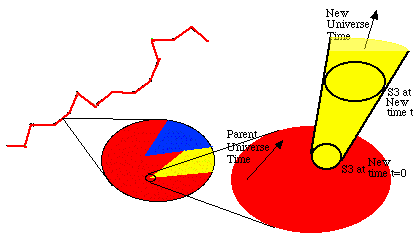
The New Universe can be regarded as
being created in a Quantum Fluctuation
Black Hole as described in hep-th/0103019
by Damien A. Easson and Robert H. Brandenberger, who study "...
consequences of cosmological scenarios in which our universe is born
from a black hole resting in a parent universe ...
- [They] have provided a solution to the horizon problem
by examining geodesics of matter falling into a black hole and
showing that it is possible to bring this matter into causal
contact before it emerges in the new universe. ...
- The size of the daughter universe was calculated from both the
Schwarzschild and the de Sitter perspectives. The Schwarzschild
calculation predicts the universe to be infinite. The integral
representing the length approaches infinity linearly. In order to
recover the same result in the de Sitter frame, we must be
matching the interior of the black hole to the spatially flat
sections of de Sitter space. This is the only way to make the
length approach infinity linearly. Hence, it appears that our
model singles out the observed, flat FRW universe via a
topological argument. ...
- this scenario does not suffer from the black hole information
loss problem since pure states evolve to pure states and
information is transferred from the parent universe to the black
hole interior universe.
- Finally, a relation between structure formation and Hawking
radiation was suggested. ...".
Such Universe Creation by Quantum Fluctuation may be consistent
with the view of Dyson, Kleban, and Susskind in hep-th/0208013,
where they say:
"... The conventional view is that the universe will end
in a de Sitter phase with all matter being infinitely diluted by
exponential expansion. ... In the following we will assume the
usual connections between quantum statistical mechanics and
thermodynamics. These assumptions{together with the existence of a
final cosmological constant - imply that the universe is eternal
but finite. Strictly speaking, by finite we mean that the entropy
of the observable universe is bounded, but we can loosely
interpret this as saying the system is finite in extent. On the
average it is in a steady state of thermal equilibrium. This is a
very weak assumption, because almost any large but finite system,
left to itself for a long enough time, will equilibrate (unless it
is integrable). However, intermittent fluctuations occur which
temporarily disturb the equilibrium. It is during the return to
equilibrium that interesting events and objects form. ... Let S be
the final thermodynamic entropy of the gas. Then on time scales of
order Tr = exp( S ) the system will undergo Poincare recurrences
... On such long time scales the second law of thermodynamics does
not prevent rare events, which effectively reverse the direction
of entropy change. Obviously, the recurrence allows the entire
process of cosmology to begin again ... What is more, the sequence
of recurrences will stretch into the infinite past and future. ...
Starting in a high entropy, "dead" configuration, if we wait long
enough, a fluctuation will eventually occur in which the inflaton
will wander up to the top of its potential, thus starting a cycle
of inflation, re-heating, conventional cosmology and heat death.
The frequency of such events is very low. The typical time for a
fluctuation to occur is of order Tr = exp( S - S0 ) ... where S is
the equilibrium entropy and S0 is the entropy of the fluctuation.
The fluctuations we have in mind correspond to early inflationary
eras during which the entropy is probably of order 10^10, while
the equilibrium entropy is of order 10^120. Thus Tr = exp( 10^120
) ... dismissing such long times as "unphysical" may be a symptom
of extreme temporal provincialism. ...
... the entropy in observable matter in today's universe ... is
of order 10^100. This means that the number of microstates that
are macroscopically indistinguishable from our world is exp(
10^100 ).
[ As to the Dyson-Kleburn-Susskind view as stated so far, I
agree. However, I disagree with their following statements: ]
But only exp( 10^10 ) of these states could have evolved
from the low entropy initial state characterizing the usual
inflationary starting point. ... imagine running these states
backward in time until they thermalize in the eventual heat bath
with entropy 10^120. Among the vast number exp( 10^120 ) of
possible initial starting points, a tiny fraction exp( 10^100 )
will evolve into a world like ours. However, all but exp( 10^10 )
of the corresponding trajectories (in phase space) are extremely
unstable to tiny perturbations. Changing the state of just a few
particles at the beginning of the trajectory will lead to
completely different states. ... As an example, consider a state
in which we leave everything undisturbed, except that we replace a
small fraction of the matter in the universe by an increase in the
amount of thermal microwave photons. In particular, we could do
this by increasing the temperature of the CMB from 2.7 degrees to
10 degrees. ... It is ... possible that we are missing some
important feature that picks out, or weights disproportionally,
the recurrences which go through a conventional evolution,
beginning with an inflationary era. However, we have no idea what
this feature would be. ...".
I, however, do have an idea what such a feature would be: It would
be that all universes follow the physics model of D4-D5-E6-E7-E8
VoDou Physics and evolve in accord with Zizzi
Quantum Inflation.
Many
Universes might be so created
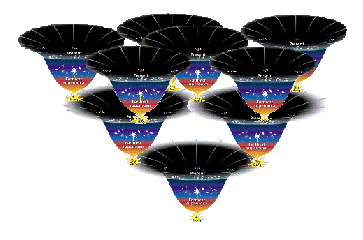
each corresponding to a Timelike
Brane in 27-dimensional J3(O) = J4(Q)o M-theory and a Spacelike Brane
in 28-dimensional J4(Q) F-theory.
The Inflationary
Universe could be based on
Complex Structure with Conformal
Symmetry: If the R4 neighborhood (in which the Expanding
Instanton is considered to be embedded) is complexified into
8-real-dimensional C4, then the Instanton becomes a bounded complex
homogeneous domain. If the Instanton has the Conformal
symmetry of 15-6-1= 8-real-dimensional Spin(6) / (Spin(4)xU(1))
then the Instanton has as its Shilov
boundary RP1 x S3 which is the spacetime structure of the
D4-D5-E6-E7-E8 VoDou Physics model.
From the HyperDiamond Lattice
Spacetime point of view, the Initial Inflationary Universe looks
like a point defect at One Vertex in the Spacetime Lattice of the
Parent Universe Spacetime. All the links from the One Vertex to other
vertices in the Parent Universe Spacetime are broken. The New
Universe Spacetime grows from the One Vertex by forming New Links
to New Vertices in the form of a New HyperDiamond Lattice Spacetime:
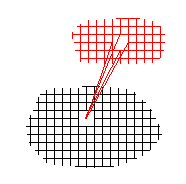
As the New Universe of the HyperDiamond
Feynman Checkerboard discrete version of the D4-D5-E6-E7-E8
VoDou Physics model grows, its boundary is always the discrete
version of a 3-sphere S3:

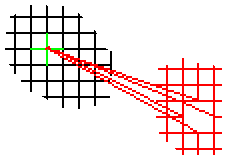
A Virtual Graviton can produce links
(shown in green) that can reconnect the
Parent Universe to the Spacetime Lattice Vertex at which the
Instanton created the New Universe. Such a Virtual Graviton would
exist only in some of the Worlds of the Many-Worlds,
but the MacroSpace
structure of the Many-Worlds might allow communication.
What is the Global Structure of the Inflationary
Universe?
Jeffrey R.
Weeks, in astro-ph/9801012, says: "If the universe is
multiply-connected and sufficiently small, then the last scattering
surface wraps around the universe and intersects itself. Each circle
of intersection appears as two distinct circles on the microwave sky.
... the matched circles [can be found, as described by Cornish,
Spergel, and Starkman in astro-ph/9801212, from the
high-resolution data to be provided by NASA's Microwave Anisotropy
Probe (MAP) in the year 2001, or by the ESA's Planck satellite a few
years later, and used] to explicitly reconstruct the global
topology of space.". Roukema
and Blanloeil, in astro-ph/9802083, say: "The space-like
hypersurface of the Universe at the present cosmological time is a
three-dimensional manifold. A non-trivial global topology of this
space-like hypersurface would imply that the apparently observable
universe (the sphere of particle horizon radius) could contain
several images of the single, physical Universe. ... Within a decade,
we should know whether or not the topology of the Universe is
detectable, and if so what it is. ...".
The boundary could be RP3 instead of ordinary S3: As
Jeffrey Weeks says in The Shape of Space, Real Projective 3-space
RP3,which can be made by identifying antipodal points of S3, has
Elliptic Geometry.
The boundary could be the Quaternionic Manifold instead of
ordinary S3: As Jeffrey Weeks says in The Shape of Space, the
Quaternionic Manifold, which can be made by opposite faces of a Cube
with a 1 / 4 clockwise turn, has Elliptic Geometry. It is
called the Quaternionic Manifold because it has Quaternionic
Symmetry.
The boundary could be T3 instead of ordinary S3: As Jeffrey
Weeks says in The Shape of Space, the 3-Torus T3, which can be made
by opposite faces of a Cube with no turn, has Euclidean
Geometry.
The boundary could be Seifert-Weber Space instead of ordinary
S3: As Jeffrey Weeks says in The Shape of Space, Seifert-Weber
Space, which can be made by opposite faces of a Dodecahedron with a 3
/ 10 clockwise turn, has Hyperbolic Geometry, as do most closed
3-manifolds.
The boundary could be the S3#
Poincare Dodecahedral Space instead of ordinary S3:
S3# is made by taking the quotient of S3 = Spin(3) = SU(2), the
double cover of SO(3), by the 120-element binary icosahedral group.
You can make an S3# by identifying opposite faces of a Dodecahedron
with a 1 / 10 clockwise turn, as described in Chapter 16 of The Shape
of Space, by Jeffrey R. Weeks (Marcel Dekker 1985). S3#, like S3, has
Elliptic Geometry. S3# is a natural spinor space, in that you
have to do a 720 degree rotation to get back to the initial state.
Jean-Pierrre Luminet, in astro-ph/0501189,
entitled "The Shape of Space after WMAP data", says:
"... the recent analysis of CMB data provided by the WMAP
satellite suggest a finite universe with the topology of the
Poincar´e dodecahedral spherical space. Such a model of a
"small universe", the volume of which would represent only about
80 % the volume of the observable universe, offers an
observational signature in the form of a predictable topological
lens effect on one hand, and rises new issues on the early
universe physics on the other hand ...
... cosmic crystallography looks at the 3-dimensional apparent
distribution of high redshift sources (e.g. galaxy clusters,
quasars) in order to discover repeating patterns in the universal
covering space, much like the repeating patterns of atoms observed
in a crystal. "Pair Separation Histograms" (PSH) are in most cases
able to detect a multiconnected topology of space, in the form of
sharp spikes standing out above the noise distribution that is
expected in the simply-connected case. ... However ... PSH may
provide a topological signal only when the holonomy group of space
has Clifford translations, a property which excludes all
hyperbolic spaces. ...
... The main limitation of cosmic crystallography is that the
presently available catalogs of observed sources at high redshift
are not complete enough to perform convincing tests ...
Fortunately, the topology of a small Universe may also be detected
through its effects on such a "Rosetta stone" of cosmology as is
the CMB fossil radiation ...
... The "concordance model" of cosmology describes the Universe
as a flat infinite space in eternal expansion, accelerated under
the effect of a repulsive "dark energy". The data collected by the
NASA satellite WMAP ... combined with other astronomical data ...
is marginally compatible with strictly flat space sections. ...
Presently ... taken at their face value, WMAP data favor a
positively curved space, necessarily of finite volume since all
spherical spaceforms possess this property. ...
Now what about space topology ? ... WMAP data ... power
spectrum of temperature anisotropies ... exhibits a set of
"acoustic" peaks when anisotropy is measured on small and mean
scales ... These peaks are remarkably consistent with the infinite
flat space hypothesis.
However, at large angular scale ( for CMB spots typically
separated by more than 60 degrees ), there is a strong loss of
power which deviates significantly from the predictions of the
concordance model. ... WMAP
has observed a value of the quadrupole 7 times weaker than
expected in a flat infinite Universe. ... The octopole ... is also
weaker (72 % of the expected value). For larger wavenumbers
... which correspond to temperature fluctuations at small angular
scales ... observations are remarkably consistent with the
standard cosmological model.
The unusually low quadrupole value means that long wavelengths
are missing. ... A ... natural explanation may be because space is
not big enough to sustain long wavelengths. ...
... the long wavelengths modes tend to be relatively lowered
only in a special family of closed multiconnected spaces called
"well-proportioned". ...
... Among the family of well-proportioned spaces, the best fit
to the observed power spectrum is the Poincare Dodecahedral Space
(hereafter PDS) ... PDS may be represented by a dodecahedron ...
whose opposite faces are glued after a 36 degree twist ... Such a
space is positively curved, and is a multiconnected variant of the
simply-connected hypersphere S3, with a volume 120 times smaller.
... The associated power spectrum, ... strongly depends on the
value of the mass-energy density parameter. ... There is a small
interval of values within which the spectral fit is ... in
agreement with the value of the total density parameter deduced
fromWMAP data ( 1.02 +/- 0.02 ). The best fit is obtained for
OMEGA_0 = 1.016 ... The result is quite remarkable because the
Poincare space has no degree of freedom. ...
... the curvature radius Rc is the same for the
simply-connected universal covering space S3 and for the
multiconnected PDS. ... a cosmological model with OMEGA_0 = 1.02
is far from being "flat" (i.e. with Rc = 1) ... For the same
curvature radius, PDS has a volume 120 times smaller than S3.
Therefore, the smallest dimension of the fundamental dodecahedron
is only 43 Gpc, and its volume about 80% the volume of the
observable universe (namely the volume of the last scattering
surface). This implies that some points of the last scattering
surface will have several copies. Such a lens effect is purely
attributable to topology and can be precisely calculated in the
framework of the PDS model. It provides a definite signature of
PDS topology ...
... To be confirmed, the PDS model ... must satisfy two
experimental tests :
1) A finer analysis of WMAP data, or new data ... will be able
to determine the value of the energy density parameter with a
precision of 1 %. A value lower than 1.01 will discard the
Poincare space as a model for cosmic space, in the sense that the
size of the corresponding dodecahedron would become greater than
the observable universe and would not leave any observable imprint
on the CMB, whereas a value greater than 1.01 would strengthen its
cosmological pertinence.
2) If space has a non trivial topology, there must be
particular correlations in the CMB, namely pairs of "matched
circles" ... The PDS model predicts 6 pairs of antipodal circles
with an angular radius less than 35 degrees. ... Cornish et al.
(2004) claimed to have found no matched circles on angular sizes
greater than 25 degrees, and thus rejected the PDS hypothesis. ...
This is a wrong statement because they searched only for antipodal
or nearly-antipodal matched circles. However ... for generic
topologies ( including the well-proportioned topologies .... ),
the matched circles are not back-to-back and space is not globally
homogeneous, so that the positions of the matched circles depend
on the observer's position in the fundamental polyhedron. The
corresponding larger number of degrees of freedom for the circles
search in the WMAP data generates a dramatic increase of the
computer time, up to values which are out&endash;of&endash;reach
of the present facilities. On the other hand, ... the same
analysis for smaller circles ... found six pairs of matched
circles distributed in a dodecahedral pattern, each circle on an
angular size about 11 degrees. This implies OMEGA_0 = 1.010 +/-
0.001 for OMEGA_m = 0.28 +/- 0.02, values which are perfectly
consistent with the PDS model. ... Eventually, the
second&endash;yearWMAP data, originally expected by February 2004
but delayed for at least one year due to unexpected surprises in
the results, may soon bring additional support to a spherical
multiconnected space model. ...
... positive curvature ... implies a finite space and sets
strong constraints on the number of e-foldings that took place
during an inflation phase. It is possible to build models of "low
scale" inflation where the inflationary phase is short and leads
to a detectable space curvature ... It turns out that, if space is
not flat, the possibility of a multiconnected topology is not in
contradiction with the general idea of inflation ...
In most cosmological models, it is generally assumed that
spatial homogeneity stays valid beyond the horizon scale. ... On
this respect, the PDS model .... requires only one expanding
bubble universe, of size sufficiently small to be entirely
observable. ... spatially closed universes had the advantage to
eliminate boundary conditions ... the PDS or a
well&endash;proportioned ... universe ... is the only type of
model in which the astronomical future could be definitely
predicted ...
Maybe the most fundamental issue is to link the
present&endash;day topology of space to a quantum origin, since
classical general relativity does not allow for topological
changes during the course of cosmic evolution. ... some simplified
solutions of Wheeler-de Witt equations show that the sum over all
topologies involved in the calculation of the wavefunction of the
universe is dominated by spaces with small volumes and
multiconnected topologies ...".
The D4-D5-E6-E7-E8 VoDou physics
model has a natural process for Inflationary Universe
Creation.
In the D4-D5-E6-E7-E8 VoDou physics model picture, the initial
Inflationary Universe Quantum Fluctuation is very small and very hot,
with a Planck Energy temperature in its Planck-size volume. As the
Instanton expands, it cools so that its temperature is, like a
Black Hole, inversely proportional to
its radius. (Unlike a Black Hole, which has maximal mass for its
volume, the Instanton temperature is not inversely proportional to
its mass.) This produces the hot Big Bang necessary for
nuceosynthesis.
Prior to dimensional reduction of spacetime from 8-dimensional to
4-dimensional, the Lagrangian for the D4-D5-E6-E7-E8 VoDou physics
model is

where the three terms represent the adjoint, scalar, and
half-spinor representations of Spin(8) and the base manifold over
which the Lagrangian is integrated represents the vector
representation,
plus a topological Pontrjagin term.
The Pontrjagin term represents Instantons in 8-dimensional
spacetime that is locally R8, so that the Instantons have as boundary
the 7-sphere S7.
After dimensional reduction to 4-dimensional spacetime, the S7
Instanton boundary is factored by the Hopf fibration S3 -> S7
-> S4 into an Instanton with S3 boundary in 4-dimensional
spacetime that is locally R4, plus an S4 part related to
4-dimensional Internal Symmetry Space.
In addition to the Standard Model, 3 generations of fermions, and
a complex U(1) propagator phase,
dimensional reduction also produces a Spin(6) = SU(4) gauge
group
that is a compact version of the 15-dimensional
Conformal Group Spin(4,2), which is generated by 4 conformal
transformations, 1 scale transformations, and 10 Spin(5) = Sp(2)
deSitter transformations.
Conformal changes in the spacetime metric can be lifted to the
fermion spinor bundle as described in Theorem 5.24 of Lawson and
Michelsohn (1989), saying that the Atiyah-Singer Dirac operator
remains essentially invariant under all changes of the metric by the
conformal group C(n) = {g in GL(n,R) : g = Lg' for L in R+ and g' in
SO(n)}. The conformal group C(n) =
Spin(n,2) is in a sense the largest group that respects the
spinor bundle on an n-dimensional manifold, which itself depends on
the choice of Riemannian metric. The introduction of a Riemannian
metric amounts to a simultaneous reduction of the structure group
GL(n,R) of the tangent bundle, the cotangent bundle, and their tensor
products to SO(n). (Lawson and Michelsohn (1989))
To get Gravity from the Spin(6) Conformal
Group,
first gauge-fix the 4 dimensions of conformal transformations
(thus linking the 4-dimensional SU(2) Higgs scalar to Gravity)
and
then gauge-fix the 1-dimensional scale transformation (thus
setting the Higgs mechanism mass scale).
After the conformal and scale gauges have been fixed, the Spin(6)
= SU(4) conformal Lagrangian becomes a Spin(5) = Sp(2) de Sitter
Lagrangian, from which gravity is obtained by the mechanism of
MacDowell and Mansouri (Phys. Rev. Lett. 38 (1977) 739).
As Nieto, Obregon,
and Socorro showed in gr-qc/9402029, the MacDowell-Mansouri
Spin(0,5) = Sp(2) de Sitter Lagrangian for gravity plus
a Pontrjagin topological term
is equal to
the Lagrangian for gravity in terms of the Ashtekar
variables plus
a cosmological constant term - which
may vary during
Expansion of the Instanton Universe (Overduin
and Cooperstock, in astro-ph/9805260,
have described some other cosmological models with variable
cosmological constant), plus
an Euler topological term - which counts the number of handles of
a maniforld and for 4-dim spacetime is a 4-form that is proportional
to the square root of the determinant of the 4x4 matrix representing
the curvature 2-form (see sec. 11.4 of Nakahara, Geometry, Topology,
and Physics, Adam Hilger 1990).
The Pontrjagin topological term that must be added to the
MacDowell-Mansouri Lagrangian to get Ashtekar gravity (with a
cosmological constant and an Euler topological term) is the
Pontrjagin term of the D4-D5-E6-E7-E8 VoDou Physics
model.
an Euler term to count the handles if the universe is
multiply connected, as might be the case if the universe contains
closed timelike loops, such as are described by Gott
and Li in their paper Can the Universe Create
Itself?;
a Pontrjagin term that can also be used for creation of a
new Inflationary Universe; and
a Cosmological Constant
L(t). that can vary during Inflation due to Particle
Creation.
WMAP observation of the
Cosmic Background Radiation indicates that live in a Flat
Expanding Universe with three types of stuff:
ordinary matter - 4% -
- According to a New Scientist (22 March 2003 pp.
41-42) article by Govert Schilling:
"... Only around a quarter (1%) of the
baryonic mass is ... in objects we can see ... stars,
galaxies, and gas clouds ... Up to another quarter (1%) ..
may be ...[in]... objects too faint for our telescopes
too pick up, such as burned-out stars, small planets, or stars
that failed to ignite ... The lost baryons ...[may
be]... strung out like cobwebs
throughout the cosmos ...
... the Virgo cluster of galaxies
...[is]... beaming out far more extreme-ultraviolet
radiation than expected. ...[because]... galaxy clusters
...[are].. filled with gas as hot as 10 million kelvin
...[which]... gives off high-energy X-rays, not
lower-energy ultraviolet radiation ... Richard Lieu ... suspected
that much cooler gas was being sucked into the galaxy cluster from
intergalactic space. ...[if so]... intergalactic space ...
is filled with a wispy gas of baryons ...
... Long before galaxies began to form, 3
billion years after the big bang, baryonic matter was spread
throughout the universe ... the gas was dominated by hydrogen ...
in today's Universe, [some of] the clouds of hydrogen
...[has been]... eaten up during galaxy formation ...
... Computer simulations ... show that ... dark
matter ... tends to be ... eventually drawn out into
filaments
...[that]... crisscross each other to form a giant cosmic
cobweb. ... the densest knots in the
web turn into ... congregations of galaxies ... According to Cen
and Ostriker's [computer] simulations ... Most of the
baryons ... are still in intergalactic space, but ... are too hot
to spot easily. ... the process of galaxy formation sends shock
waves through intergalactic space, heating the gas to about 1
milion kelvin. ... [the] baryons [are] spread so
thinly ... that they cannot transfer heat to each other
...[or]... cool efficiently. ... they .... would beam out
low-energy X-rays and extreme-ultraviolet radiation. ...
... theory predicts ... that ... highly ionized
oxygen ... produced in the first generation of stars, which later
exploded, scattering their contents like confetti throughout the
Universe ...[among the lost baryons] ... Tripp and Savage
... found that ... radiation from ... quasars was being absorbed
by oxygen ions ... in intergalactic space. ...".
cold dark matter (such as black
holes,ranging in size from the stable Planck
mass to Jupiter mass, and
possibly some gravitational
interactions from other Worlds of the Many-Worlds) - 23% ; and
a Cosmological Constant L(t) - 73%
.
In the D4-D5-E6-E7-E8 VoDou Physics
model, Gravity and the Cosmological
Constant come from the MacDowell-Mansouri Mechanism and the
15-dimensional Spin(2,4) = SU(2,2) Conformal
Group, which is made up of:
- 3 Rotations;
- 3 Boosts;
- 4 Translations;
- 4 Special Conformal transformations; and
- 1 Dilatation.
According to gr-qc/9809061
by R. Aldrovandi and J. G. Peireira:
"... By the process of Inonu&endash;Wigner group
contraction with R -> oo ...[where R ]... the de Sitter
pseudo-radius ... , both de Sitter groups ... with metric ...
(-1,+1,+1,+1,-1) ...[or]... (-1,+1,+1,+1,+1) ... are
reduced to the Poincare group P, and both de Sitter spacetimes are
reduced to the Minkowski space M. As the de Sitter scalar
curvature goes to zero in this limit, we can say that M is a
spacetime gravitationally related to a vanishing cosmological
constant.
On the other hand, in a similar fashion but taking the limit R
-> 0, both de Sitter groups are contracted to the group Q,
formed by a semi&endash;direct product between Lorentz and special
conformal transformation groups, and both de Sitter spaces are
reduced to the cone&endash;space N, which is a space with
vanishing Riemann and Ricci curvature tensors. As the scalar
curvature of the de Sitter space goes to infinity in this limit,
we can say that N is a spacetime gravitationally related to an
infinite cosmological constant.
If the fundamental spacetime symmetry of the laws of Physics is
that given by the de Sitter instead of the Poincare group, the
P-symmetry of the weak cosmological&endash;constant limit and the
Q-symmetry of the strong cosmological&endash;constant limit can be
considered as limiting cases of the fundamental symmetry.
Minkowski and the cone&endash;space can be considered as dual
to each other, in the sense that their geometries are determined
respectively by a vanishing and an infinite cosmological
constants. The same can be said of their kinematical group of
motions: P is associated to a vanishing cosmological constant and
Q to an infinite cosmological constant.
The dual transformation connecting these two geometries is the
spacetime inversion x^u -> x^u / sigma^2 . Under such a
transformation, the Poincare group P is transformed into the group
Q, and the Minkowski space M becomes the cone&endash;space N. The
points at infinity of M are concentrated in the vertex of the
cone&endash;space N, and those on the light&endash;cone of M
becomes the infinity of N. It is interesting to notice that,
despite presenting an infinite scalar curvature, the concepts of
space isotropy and equivalence between inertial frames in the
cone&endash;space N are those of special relativity. The
difference lies in the concept of uniformity as it is the special
conformal transformations, and not ordinary translations, which
act transitively on N. ...
... in the light of the recent supernovae results ... favoring
possibly quite large values for the cosmological constant, the
above results may acquire a further relevance to Cosmology
...".
Since the Cosmological Constant comes from the 10 Rotation, Boost,
and Special Conformal generators of the Conformal
Group Spin(2,4) = SU(2,2), the fractional part of our Universe of
the Cosmological Constant should be about 10 / 15 = 67%.
Since Black Holes, including Dark Matter Primordial
Black Holes, are curvature singularities in our 4-dimensional
physical spacetime, and since Einstein-Hilbert curvature comes from
the 4 Translations of the 15-dimensional Conformal
Group Spin(2,4) = SU(2,2) through the MacDowell-Mansouri Mechanism
(in which the generators
corresponding to the 3 Rotations and 3 Boosts do not propagate),
the fractional part of our Universe of Dark Matter Primordial
Black Holes should be about 4 / 15 = 27%.
Since Ordinary Matter gets mass from the Higgs mechanism which is
related to the 1 Scale Dilatation of the 15-dimensional Conformal
Group Spin(2,4) = SU(2,2), the fractional part of our universe of
Ordinary Matter should be about 1 / 15 = 6%.
Therefore, our Flat Expanding Universe should, according to the
cosmology of the D4-D5-E6-E7-E8
VoDou Physics model, have, roughly:
67% Cosmological Constant -
- related to GraviPhotons of Special
Conformal transformations and Akira/Tetsuo
Energy.
27% Dark Matter -
- such as black holes, ranging
in size from the stable Planck
mass to Jupiter mass;
possibly some gravitational
interactions from other Worlds of the Many-Worlds; and/or
effective contributions from MOND.
6% Ordinary Matter -
- According to a New Scientist (22 March 2003
pp. 41-42) article by Govert Schilling: "... Only around
(1%) ... is ... in objects we can see ... stars, galaxies,
and gas clouds ... Up to another ... (1%) .. may be
...[in]... objects too faint for our telescopes too pick
up, such as burned-out stars, small planets, or stars that failed
to ignite ... The ...[ other 4% ] ...[may
be]... strung out
like cobwebs
throughout the cosmos ...".
In my opinion,
Also, there may be gravitational
interaction from other Worlds of the Many-Worlds.
Aldrovandi and
Pereira, in gr-qc/9809061, show that de
Sitter groups of the MacDowell-Mansouri Gravity mechanism can
describe Special Relativity in SpaceTimes with varying Cosmological
Constant. They use Inonu-Wigner contractions of de Sitter groups and
spaces to show that in a weak cosmological-constant limit the de
Sitter groups are contracted to the Poincare group, and the de Sitter
spaces are reduced to the Minkowski space, while in the strong
cosmological-constant limit the de Sitter groups are contracted to
another group which has the same abstract Lie algebra of the Poincare
group, and the de Sitter spaces are reduced to a 4-dimensional
cone-space of infinite scalar curvature, but vanishing Riemann and
Ricci curvature tensors, in which the special conformal
transformations act transitively and the equivalence between inertial
frames is that of special relativity. If the fundamental spacetime
symmetry of the laws of Physics is that given by the de Sitter
instead of the Poincare group, the P-symmetry of the weak
cosmological constant limit and the Q-symmetry of the strong
cosmological constant limit can be considered as limiting cases of
the fundamental symmetry. Minkowski and the cone-space can be
considered as dual to each other, in the sense that their geometries
are determined respectively by vanishing and infinite cosmological
constants. The same can be said of their kinematical group of
motions.
The creation of the Inflationary Universe
by Quantum Fluctuation has some similarities to the quantum conformal
fluctuation approach of Narlikar and Padmanabhan (1986) and Gunzig,
Geheniau, and Prigogine (1987) and Gunzig
(1997)).
For a movie that shows the creation of a new universe from our
universe, see Akira.
Since, after dimensional reduction of spacetime from 8 to 4
dimensions, the Pontrjagin term goes into the Spin(6) conformal
gravity sector of the D4-D5-E6-E7-E8 VoDou
Physics model, it does not go to the SU(3) color force sector.
Therefore, the SU(3) color force Sector has no THETA-term and the
D4-D5-E6-E7-E8 VoDou Physics model has
no theoretical THETA-CP
problem.
The relationship between the
Einstein curvature tensor G of Gravity, the stress-enregy tensor T of
the particles and fields of the Standard Model, and a variable
cosmological constant LAMBDA can be seen from the Einstein
equation
G = 8 pi T - LAMBDA g
Overduin and Cooperstock, in astro-ph/9805260,
have described some other cosmological models with variable
cosmological constant.
During its Inflationary Era, the Inflationary
Universe has an effective Cosmological Constant L(t) that causes
particle creation (qualitatively somewhat similarly to the C-field
of Hoyle's Steady-State cosmology).
From the fundamental Planck-length
HyperDiamond Lattice spacetime point of view, during the
Inflationary Era, new lattice vertices appear uniformly distributed
among the old lattice vertices.
Without the new vertices due to Expansion, virtual Quantum
Fluctuation particle-antiparticle pairs appear, move apart for a
while, and then come back together and annihilate each other.
If a new vertex alters spacetime near the path of one of such a
pair, and thus alters its path so that it does not annihilate the
other member of the pair, then the virtual Quantum Fluctuation can
create new real pairs of Planck-Mass Black
Holes, which can merge with pre-existing Black
Holes to form larger Black Holes, which can then decay and
produce various real particles and antiparticles.
If a Black Hole has greater than the stable minimum Planck mass,
it will decay with a lifetime that is proportional to the cube of its
mass. For a Black Hole to survive about 20 billion years, it must
have a mass of at least 2 x 10^14 grams. For comparison, the Earth
has mass of 6 x 10^27 grams and the Sun has a mass of 2 x 10^33
grams. A Black Hole of the mass of the
Sun would have a radius (proportional to its mass) of about 10^5 cm,
or 1 km.
The temperature of a Black Hole increases as it evaporates, with a
temperature that is inversely proportional to its mass, and,
equivalently, inversely proportional to its radius. A Black Hole of
the mass of the Sun would have a temperature of 10^(-6) degrees
K.
Since small Black Holes are hot, any particles (fermions, bosons,
or Higgs scalars) emitted by small Black Holes would be emitted at
high temperature.
Why are there more particles than antiparticles in our
universe?
To produce particle/antiparticle asymmetry, you need processes
that are non-equilibrium and that are also CP-violating. Two such
processes are:
The decay of Black Holes. According
to Turner (1979) and Dolgov (1980), Black Hole decay could account
for the particle-antiparticle asymmetry and the baryon-photon ratio
of 5 x 10^(-10) that is observed now.
Another possible mechanism for particle-antiparticle asymmetry is
the set of interactions that may occur at the weak
force phase transition.
Since cold Black Holes interact with
the ordinary matter only gravitationally, their evolution is
discussed separately from the evolution of hot
ordinary matter (fermions, bosons, and Higgs scalars).
Immediately After Inflation - Reheating:
At the end of inflation:
- the time Tdecoh = 10^(-34 sec)
- the number of qubits is Ndecoh = 10^19 = 2^64
Each qubit at the end of inflation corresponds to a Planck
Mass Black Hole, which in the
D4-D5-E6-E7-E8 VoDou Physics model undergoes decoherence and,
in a process corresponding to Reheating in the Standard
Inflationary Model,
each qubit transforms into
2^64 = 10^19 elementary first-generation fermion
particle-antiparticle pairs.
The resulting 2^64 x 2^64 = 2^128 = 10^19 x 10^19 = 10^38 fermion
pairs populating the Universe Immediately After Inflation constitutes
a Zizzi Quantum Register of order n_reh = 10^38 = 2^128.
Since, as Paola Zizzi says in gr-qc/0007006,
( with some editing by me denoted by [ ] ): "... the quantum
register grows with time. ... At time Tn =
(n+1) Tplanck the quantum gravity register will consist of (n+1)^2
qubits. [ Let N = (n+1)^2 ] ...", we have the number of
qubits at Reheating:
Nreh = ( n_reh )^2 = ( 12^128 )^2 = 2^256 = 10^77
Since each qubit at Reheating should correspond, not to Planck
Mass Black Holes, but to fermion
particle-antiparticle pairs that average about 0.66 GeV, we have
the result that
the number of particles in our Universe at Reheating is
about 10^77 nucleons.
After Reheating, our Universe enters the Radiation-Dominated Era,
and, since there is no continuous creation, particle production
stops, so
the 10^77 nucleon Baryonic
Mass of our Universe has been mostly constant since
Reheating,
and will continue to be mostly constant until Proton
Decay.
In the paper
gr-qc/0007006, Paola Zizzi says [with
changes by me enclosed in square brackets - the paper
states that at the end of inflation En = Eplanck / 10^9 = 10^11 GeV,
but since I consider Eplanck to be 10^19 GeV, I use the value 10^10
GeV]: "... The discrete energy spectrum of the de Sitter
horizon states at time Tn = ( n+1 ) Tplanck ... is En = Eplanck / (
n+1 ) where Eplanck = 1.2 x 10^19 GeV is the Planck energy ...[so
that at]... the decoherence time ... Tn = 10^(-34) sec ... the
time when inflation ends ... the corresponding energy is [ Edecoh
= Eplanck / 10^9 = 10^10 GeV ] ...".
However, the Reheating process raises the energy/temperature at
Reheating to Ereh = 10^14 GeV, the geometric mean of the Eplanck =
10^19 GeV and Edecoh = 10^10 GeV:
Ereh = sqrt( Eplanck Edecoh ) = sqrt( 10^29 ) GeV = 10^14
GeV.
In the D4-D5-E6-E7-E8 VoDou Physics
model,
Protons Decay
by Virtual Black Holes over
about 10^64 years,
according to Hawking
and his students who have studied the
physical consequences of creation of virtual pairs of Planck-energy
Black Holes,
and
John Gribbin, in his book In Search of the Big Bang (Bantam 1986,
page 374), says that Einstein was stopped in the street because
George Gamow had just told Einstein about the idea of ceating the
Universe from Nothing, which had been just then (in the 1940s) been
thought of by Pascual Jordan. See the autobiography My World Line of
George Gamow.
Tony Smith's Home Page
......













